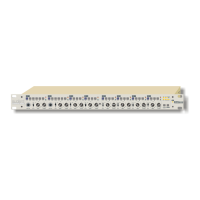11
©audient 05/2008
Operation Manual
Variable Impedance
Variable Impedance: What is it and what does it do?
Traditionally, in order to get the maximum signal transfer between microphone and
pre-amp, the recommended practice has been to ensure that the input impedance of
the pre-amp is at least 5 times the source impedance of the microphone. In other words,
a typical 200 Ohm microphone needs a 1kOhm input impedance. The mic is essentially
working without any load and is able to generate its maximum output voltage,
optimising the signal to noise ratio and usually providing the flattest frequency response
(or at least the frequency response the manufacturer intended). However, subtle
changes in tonal quality and microphone performance can be invoked by deliberately
making the microphone work harder by loading it with a different impedance.
The timbral changes caused by this can range from inaudible to quite dramatic, involving
a complex and interactive range of effects including level, frequency response, and
transient response.
The results will generally be most noticable on older ribbon and dynamic microphones,
which are transformer coupled. The loading on the transformer usually causes frequency
response and level changes, sometimes ironing out resonances. At the same time, the
increased damping of the magnetic circuit in which the ribbon or moving coil vibrates
causes changes to transient response. This is similar to the well known effect that
different amps can have on electric guitars, where the sustain is affected. Basically, the
loading on the guitar pickup "stiffens" the magnetic field in which the string is vibrating,
opposing the movement of the string.
Capacitor microphones tend to be less affected, especially modern transformerless types
that have a lower source impedance. The electronics in these microphones isolates the
effect of the loading from the capsule. Older transformer coupled types tend to be
better candidates for tonal manipulation, as they have a more complex source
impedance.
It is difficult to predict what the effect will be on any given microphone. Generally, a
higher input impedance (less loading) will give a more transparent, wide range sound,
while a lower input impedance (more loading) will increase warmth and reduce level.
The ASP008 provides a choice of three impedances, 200 Ohm, 1.2kOhm, and 5kOhm.
Don't be afraid to experiment. This is a technique that can easily extend the use and
application of your microphone collection. Remember, it's the sound that's important,
not the theory!

